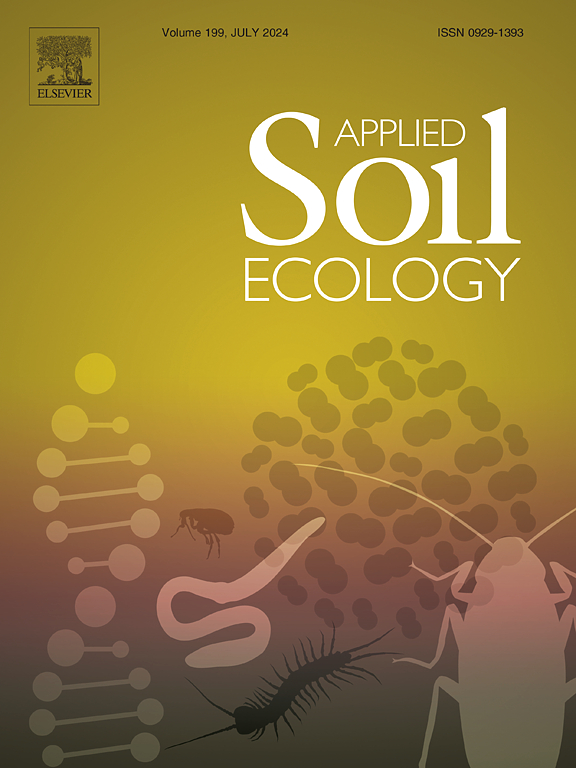Root-soil-microbe interactions mediate phosphorus and iron uptake from lithium iron phosphate nanomaterials
IF 5
2区 农林科学
Q1 SOIL SCIENCE
引用次数: 0
Abstract
Addressing the critical challenge posed by the rapidly increasing amount of end-of-life lithium iron phosphate (LiFePO₄) batteries from electric vehicles and various industries, the presence of iron (Fe) and phosphorus (P), both essential plant nutrients in LiFePO₄, provides an opportunity to transform waste into valuable resources. This study explores an innovative strategy to sustainably utilize LiFePO₄ nanoparticles (n-LiFePO4) as a fertilizer in a peanut (Fe-deficiency) and maize (P-deficiency) intercropping system to enhance crop productivity. We chose 50 and 250 mg/kg of n-LiFePO4 mixed with soil and applied in monocropping maize, monocropping peanut and intercropping. The same content of P and Fe of ionic groups as n-LiFePO4 was added as P and Fe fertilizer control. The final control group (CK) received no amendments. The results showed that n-LiFePO4 at 50 mg/kg significantly increased root dry weight by 80 % compared to the control. While n-LiFePO4 at 250 mg/kg still exhibited positive effects, the same concentration of Fe2+ reduced peanut root biomass by 23 %. Mechanistically, the improvements are attributed not only to the sustained release of P and Fe from n-LiFePO4 but also to the stimulation of maize root exudation. This altered exudate profile positively influenced rhizosphere soil pH and enhanced the enrichment of Fe-solubilizing and P-mobilizing bacteria. These findings demonstrate that n-LiFePO₄ effectively enhances agricultural productivity, and intercropping systems further amplify these benefits through root-soil-microbe interactions, providing a promising strategy for sustainable crop management.

根-土壤-微生物相互作用介导磷酸铁锂纳米材料对磷和铁的吸收
为了解决电动汽车和各种行业中报废磷酸铁锂(LiFePO₄)电池数量迅速增加所带来的严峻挑战,LiFePO₄中存在的铁(Fe)和磷(P)都是必不可少的植物营养物质,为将废物转化为有价值的资源提供了机会。本研究探索了在花生(缺铁)和玉米(缺磷)间作系统中可持续利用lifepo4纳米颗粒(n-LiFePO4)作为肥料以提高作物生产力的创新策略。选择50和250 mg/kg n-LiFePO4与土壤混作,分别施用于单作玉米、单作花生和间作。添加与n-LiFePO4相同离子基的磷、铁含量作为磷、铁肥对照。最终对照组(CK)不做任何修改。结果表明,施用50 mg/kg n-LiFePO4后,根系干重较对照显著增加80%;250 mg/kg n-LiFePO4处理对花生根系生物量仍有积极影响,但相同浓度的Fe2+处理使花生根系生物量减少23%。从机理上讲,这种改善不仅归因于n-LiFePO4对磷和铁的持续释放,还归因于玉米根系分泌物的刺激。这种分泌物形态的改变对根际土壤pH值产生了积极影响,并增加了增铁和动磷细菌的富集。这些发现表明,n- lifepo4有效提高了农业生产力,间作系统通过根-土壤-微生物的相互作用进一步扩大了这些效益,为可持续作物管理提供了一种有希望的策略。
本文章由计算机程序翻译,如有差异,请以英文原文为准。
求助全文
约1分钟内获得全文
求助全文
来源期刊

Applied Soil Ecology
农林科学-土壤科学
CiteScore
9.70
自引率
4.20%
发文量
363
审稿时长
5.3 months
期刊介绍:
Applied Soil Ecology addresses the role of soil organisms and their interactions in relation to: sustainability and productivity, nutrient cycling and other soil processes, the maintenance of soil functions, the impact of human activities on soil ecosystems and bio(techno)logical control of soil-inhabiting pests, diseases and weeds.
 求助内容:
求助内容: 应助结果提醒方式:
应助结果提醒方式:


